Key takeaways:
- Selective mutism is an anxiety disorder affecting children’s ability to communicate in certain situations, necessitating empathy and supportive tools from caregivers.
- Visual aids, such as picture books, flashcards, and emotion wheels, help children express their feelings and reduce anxiety by providing non-verbal means of communication.
- Personal experiences highlight how visual aids foster a sense of control, independence, and connection, encouraging children to articulate their feelings and choices effectively.
- Creating a supportive environment with visual tools promotes meaningful dialogue between children and caregivers, enhancing emotional understanding and communication skills.
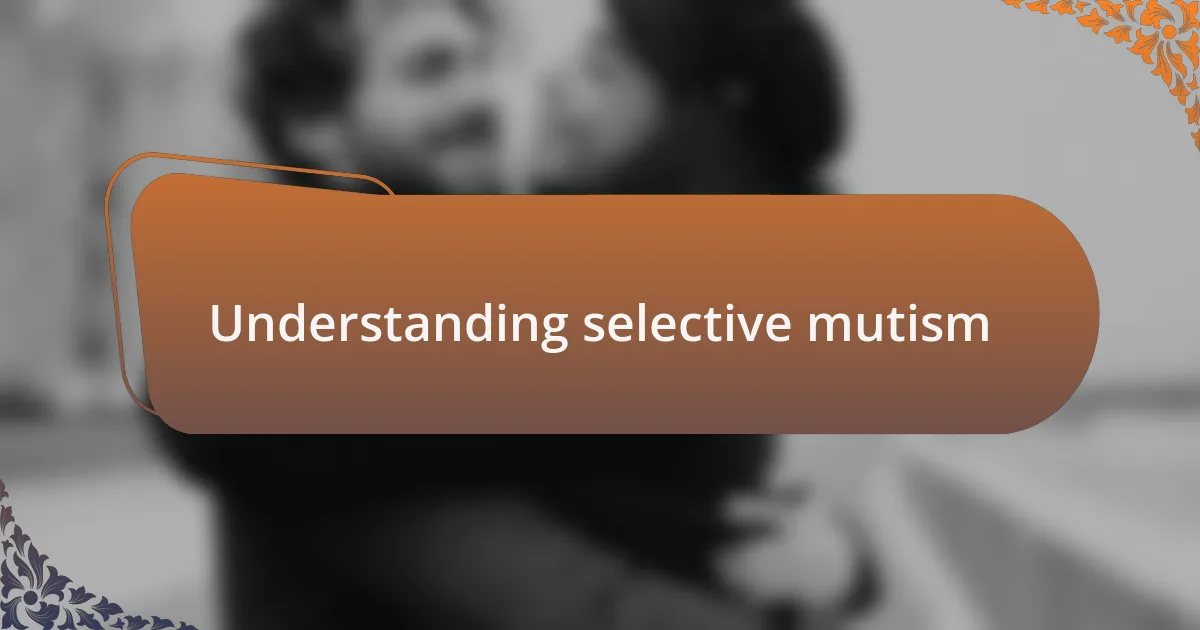
Understanding selective mutism
Selective mutism is a complex anxiety disorder that primarily affects children, who may struggle to speak in certain situations, such as at school or in social settings. I remember a time when my niece, usually chatty at home, would freeze up around her classmates. It broke my heart to see her so visibly anxious—what is it about that environment that creates such fear?
At its core, selective mutism isn’t just about not speaking; it’s a profound disconnect between wanting to communicate and the overwhelming anxiety that prevents it. I’ve often wondered how isolating it must feel for a child to have so much to say but not the means to express it in a world that often demands immediate interaction. It’s essential to recognize that this is not a choice or a defiance of will; rather, it’s a genuine struggle with fear and anxiety.
Understanding selective mutism requires empathy and patience, both from caregivers and peers. I recall a workshop I attended where the facilitator emphasized using visual aids and supportive environments to help bridge the communication gap. Have you ever considered how much a simple picture or a word card can empower a child? Those tools can create safe spaces for expression, showing children that their voices matter, even if they don’t always feel ready to use them.
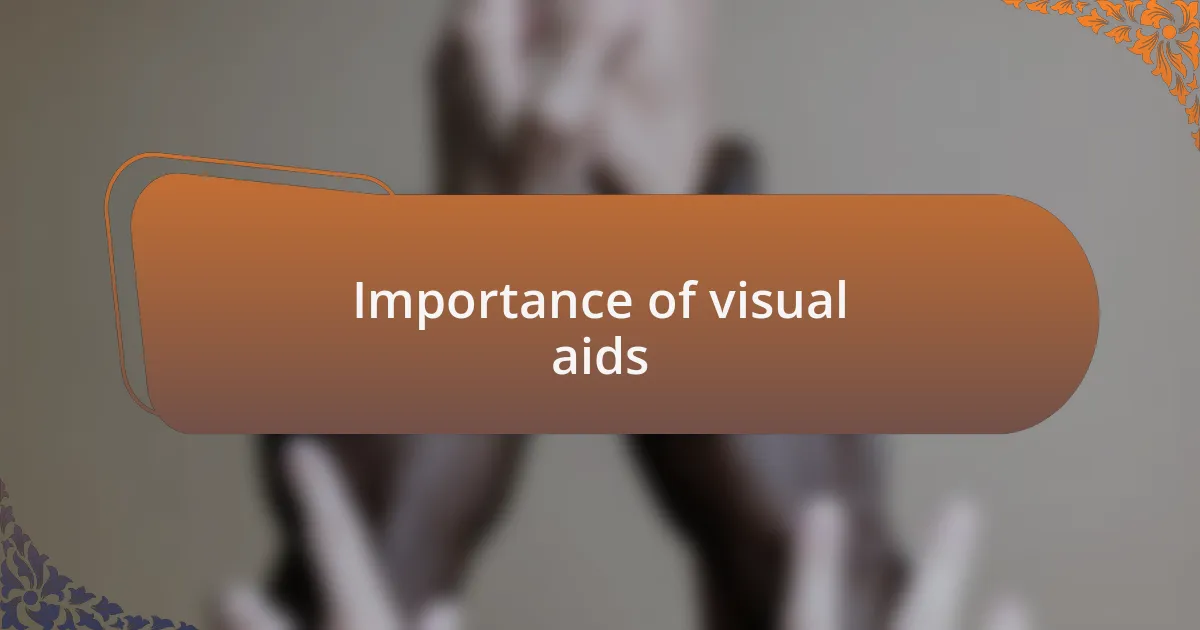
Importance of visual aids
Visual aids play a crucial role in helping children with selective mutism feel more secure in expressing themselves. I remember setting up a visual schedule for my niece that included images of different emotions and activities. This simple tool allowed her to point to what she felt or wanted to say instead of relying solely on spoken words. It was incredible to witness how her anxiety lessened when she could visually navigate her feelings.
Moreover, visual aids encourage participation without putting the pressure on verbal communication. Think about a time when you felt overwhelmed in a conversation—sometimes, having a visual cue can help steer you in the right direction. For my niece, using a picture book helped her find the words to describe her day when she felt too anxious to articulate them verbally. This approach not only gave her a voice but also helped her build confidence over time.
Incorporating visuals into communication strategies fosters a supportive environment. I’ve seen firsthand how children feel empowered to connect with others when they have manageable tools to express their thoughts. What if every child struggling to speak could experience that same relief? It’s essential to recognize that these small, visual aids can create significant shifts in how they interact with the world, paving the way for more meaningful engagement.
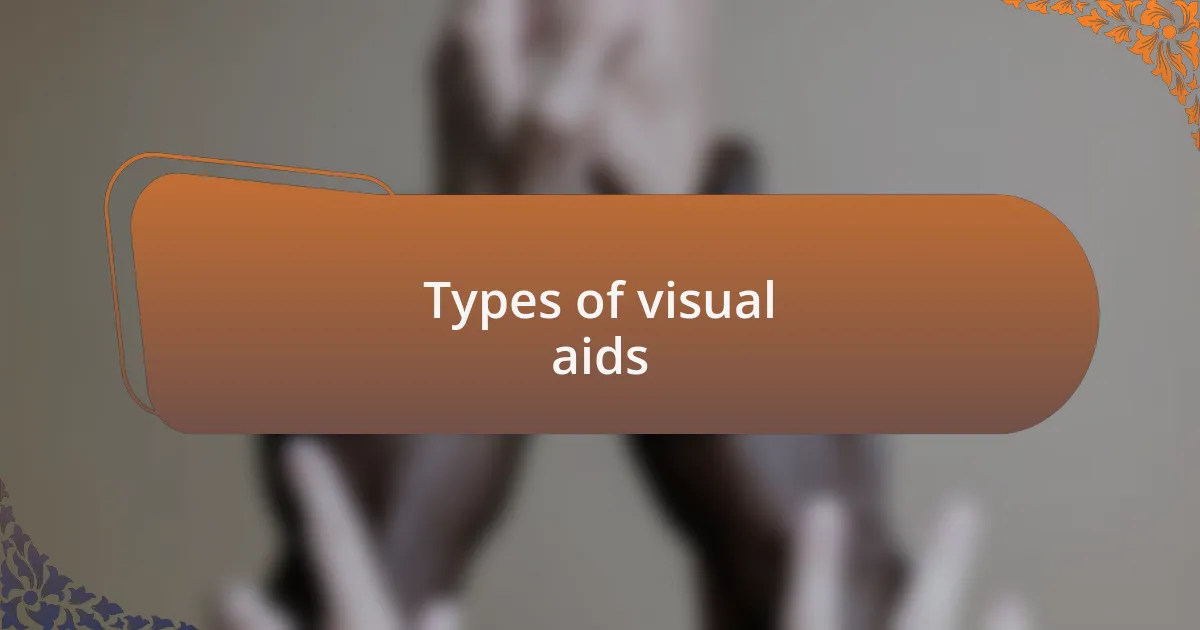
Types of visual aids
Types of visual aids can vary greatly in both form and function. One effective type I encountered was flashcards, which I crafted with images and simple words to represent emotions and daily activities. I remember watching my nephew flip through them and gradually point to the card representing “happy” on days when he felt more at ease. Isn’t it fascinating how such straightforward tools can unlock communication barriers?
Another type that proved invaluable were social stories, which combined illustrations with narratives to help my niece understand social interactions. We personalized her stories by depicting scenarios she found challenging, like asking a question in class. I noticed that as she read these stories, her anxiety would visibly decrease. What if all kids could have their feelings validated through relatable stories?
Lastly, visual schedules served as essential guides to structure daily routines. I created one with colorful visuals to represent each activity, which helped my children navigate through transitions smoothly. Seeing the excitement on their faces when they understood what came next was heartwarming. How could we underestimate the power of knowing what to expect? Visual aids in these diverse forms truly empower kids to communicate and engage on their own terms.
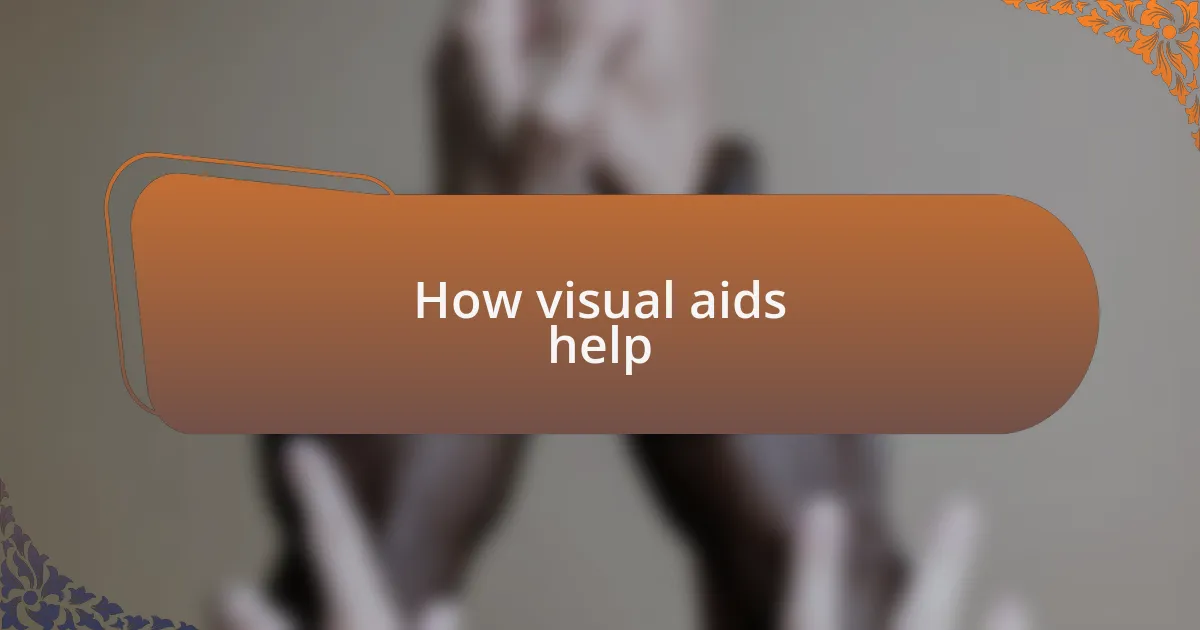
How visual aids help
Visual aids have a unique ability to bridge the gap between silence and expression. I remember using charts with stickers to track my child’s emotions throughout the week. Each time he placed a sticker, it felt like he was sharing a piece of himself without uttering a word. It was a breakthrough moment, reinforcing that he didn’t have to verbalize every feeling to be understood. Have you ever experienced that magical connection through simple visuals?
On another occasion, I introduced a picture-based communication board during a family game night. At first, my daughter was hesitant, but as she began selecting images for “my turn” or “more juice,” I saw her face light up with joy. It was as if she discovered a hidden power of expression right within her grasp. Isn’t it incredible how visual aids can transform a moment of hesitation into one of confidence and connection?
Additionally, I found that using visuals in everyday scenarios, like cooking or shopping, made a significant impact. By displaying images of ingredients or items on a list, my children could actively participate in decisions and tasks. Watching them point and engage made me realize that these aids do more than assist—they foster independence and a sense of belonging. Could this be the key to unlocking their potential?
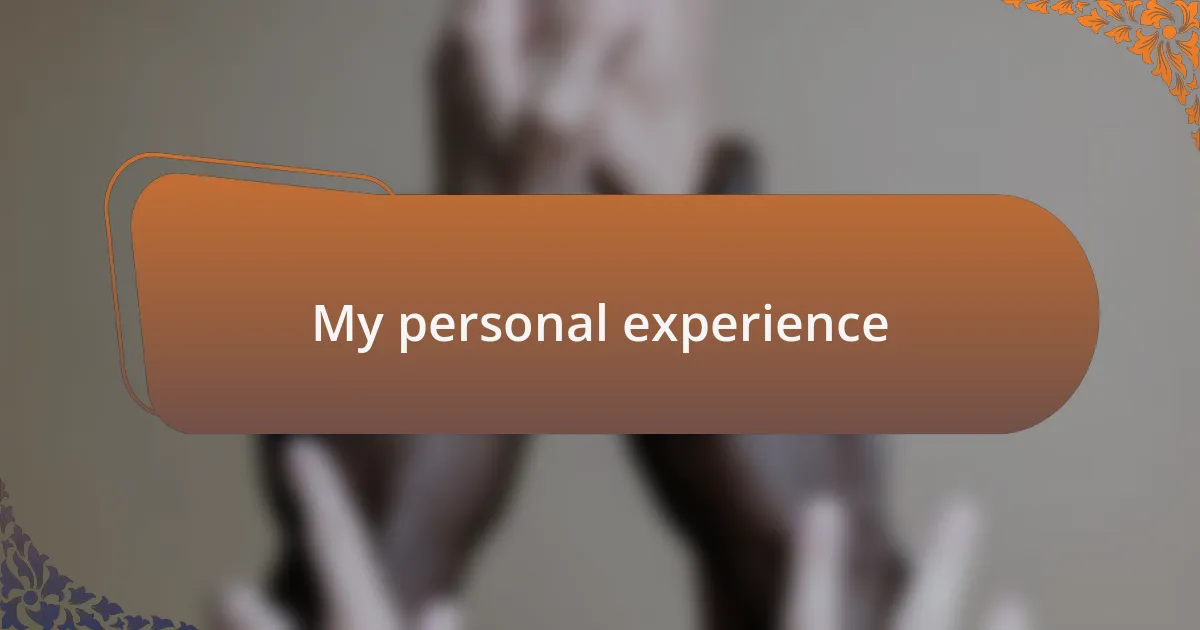
My personal experience
I remember a moment when I created a daily routine visual chart for my son. The first time he saw it, his eyes widened with curiosity. As he began to check off each task, I could almost feel the surge of accomplishment radiating from him. It was a reminder to me of how empowering visual aids can be in fostering a sense of control and routine.
One particularly vivid memory is when we used a simple emotion wheel during a family discussion. I noticed my daughter staring at it intently, and then she pointed to “anxious.” In that moment, something clicked. Instead of just nodding or agreeing, she was articulating her feelings, however indirectly. It struck me that sometimes, visuals act like a gentle nudge, guiding our children to find their voice.
There was a time when we were preparing for a family trip, and I created a visual packing list. I involved my kids by letting them choose pictures of items they wanted to pack. Watching them strategize about what to bring was not just amusing; it was heartwarming. These little interactions made me realize that visuals are more than just tools; they’re gateways to shared experiences and deeper understanding. Have you ever felt that sense of togetherness through a simple image?
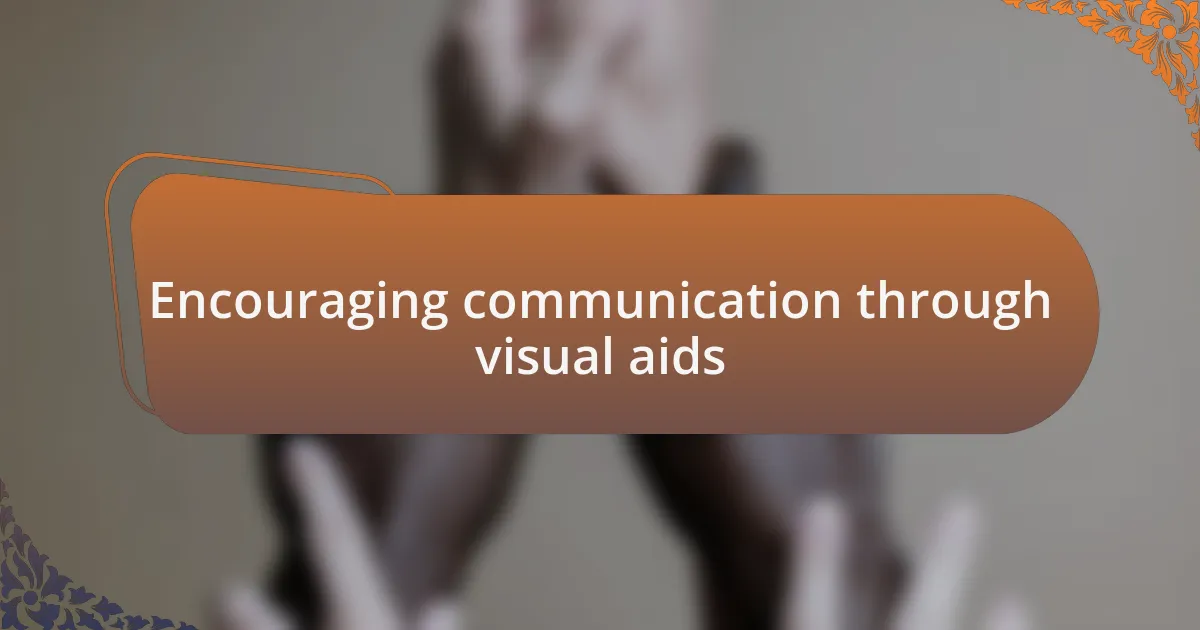
Encouraging communication through visual aids
Visual aids can truly transform how our children express themselves. I recall a time when I introduced a visual schedule for storytime. My youngest, who often struggled to vocalize his preferences, suddenly lit up when he could point to the book cover he wanted. It was a small yet significant moment—seeing him take ownership of his choices made me realize that visuals can bridge communication gaps and enhance confidence.
I also experimented with a “feelings board” during our family dinners. Each evening, I displayed images representing various emotions. One night, my daughter surprised me by using it to convey that she felt “overwhelmed.” Her courage to share, inspired by the visuals, led to an open conversation that I hadn’t anticipated. It made me wonder—how often do we provide our children with the tools to speak their truths?
In my experience, creating these visual representations fosters an inviting atmosphere for dialogue. Once, I used a visual story map while discussing plans for the upcoming holidays. My kids’ enthusiasm grew as we added stickers to illustrate favorite activities, turning our discussion into a shared adventure. This approach not only encourages communication but helps build a stronger connection with our children. Isn’t it remarkable how an image can spark conversations that words often struggle to ignite?